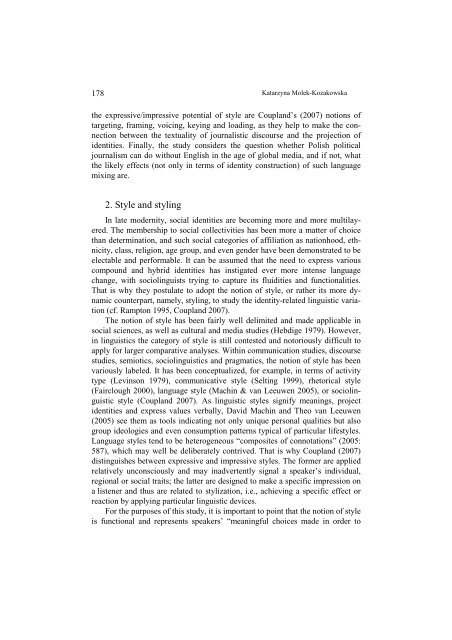s - Wyższa SzkoÅa Filologiczna we WrocÅawiu
s - Wyższa SzkoÅa Filologiczna we WrocÅawiu
s - Wyższa SzkoÅa Filologiczna we WrocÅawiu
Create successful ePaper yourself
Turn your PDF publications into a flip-book with our unique Google optimized e-Paper software.
178<br />
Katarzyna Molek-Kozakowska<br />
the expressive/impressive potential of style are Coupland’s (2007) notions of<br />
targeting, framing, voicing, keying and loading, as they help to make the connection<br />
bet<strong>we</strong>en the textuality of journalistic discourse and the projection of<br />
identities. Finally, the study considers the question whether Polish political<br />
journalism can do without English in the age of global media, and if not, what<br />
the likely effects (not only in terms of identity construction) of such language<br />
mixing are.<br />
2. Style and styling<br />
In late modernity, social identities are becoming more and more multilayered.<br />
The membership to social collectivities has been more a matter of choice<br />
than determination, and such social categories of affiliation as nationhood, ethnicity,<br />
class, religion, age group, and even gender have been demonstrated to be<br />
electable and performable. It can be assumed that the need to express various<br />
compound and hybrid identities has instigated ever more intense language<br />
change, with sociolinguists trying to capture its fluidities and functionalities.<br />
That is why they postulate to adopt the notion of style, or rather its more dynamic<br />
counterpart, namely, styling, to study the identity-related linguistic variation<br />
(cf. Rampton 1995, Coupland 2007).<br />
The notion of style has been fairly <strong>we</strong>ll delimited and made applicable in<br />
social sciences, as <strong>we</strong>ll as cultural and media studies (Hebdige 1979). Ho<strong>we</strong>ver,<br />
in linguistics the category of style is still contested and notoriously difficult to<br />
apply for larger comparative analyses. Within communication studies, discourse<br />
studies, semiotics, sociolinguistics and pragmatics, the notion of style has been<br />
variously labeled. It has been conceptualized, for example, in terms of activity<br />
type (Levinson 1979), communicative style (Selting 1999), rhetorical style<br />
(Fairclough 2000), language style (Machin & van Leeu<strong>we</strong>n 2005), or sociolinguistic<br />
style (Coupland 2007). As linguistic styles signify meanings, project<br />
identities and express values verbally, David Machin and Theo van Leeu<strong>we</strong>n<br />
(2005) see them as tools indicating not only unique personal qualities but also<br />
group ideologies and even consumption patterns typical of particular lifestyles.<br />
Language styles tend to be heterogeneous “composites of connotations” (2005:<br />
587), which may <strong>we</strong>ll be deliberately contrived. That is why Coupland (2007)<br />
distinguishes bet<strong>we</strong>en expressive and impressive styles. The former are applied<br />
relatively unconsciously and may inadvertently signal a speaker’s individual,<br />
regional or social traits; the latter are designed to make a specific impression on<br />
a listener and thus are related to stylization, i.e., achieving a specific effect or<br />
reaction by applying particular linguistic devices.<br />
For the purposes of this study, it is important to point that the notion of style<br />
is functional and represents speakers’ “meaningful choices made in order to
















